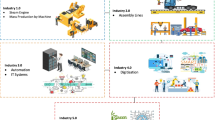Abstract
This study proposes an innovative information resource and service, a digital equipment identifier (DEI) system. The DEI system is a new identification scheme that assigns each piece of equipment a unique identification, based on which various applications can be practiced. When users employ the DEI system to access the data of a piece of equipment by using its DEI, they are directly led to the most up-to-date information about the equipment. The DEI is also useful for establishing a facility layout online because the pictures and other basic data of each piece of equipment in the facility layout can be referenced through the DEI system. A virtual capacity network containing possible vendors and factories of an equipment piece is established according to the DEI of the equipment. An optimal capacity allocation plan is then derived to maximize the average satisfaction levels of factories; therefore, an integer-nonlinear programming problem is solved. The planning results become crucial inputs in establishing a dynamic virtual factory that embodies the changes in capacity over time.










Similar content being viewed by others
References
Archimede, B., Letouzey, A., Memon, M. A., & Xu, J. (2014). Towards a distributed multi-agent framework for shared resources scheduling. Journal of Intelligent Manufacturing, 25(5), 1077–1087.
Agarwal, S. (2013). API vs. SOA? Are they different? https://blog.soa.com/api-vs-soa-different/.
Ahlerta, K.-H., Corstena, H., & Gössingerb, R. (2009). Capacity management in order-driven production networks-A flexibility-oriented approach to determine the size of a network capacity pool. International Journal of Production Economics, 118(2), 430–441.
Bohn, H., Bobek, A., & Golatowski, F. (2006). Sirena - service infrastructure for real-time embedded networked devices: A service oriented framework for different domains. In Proceedings of the international conference on networking, systems, mobile communications, and learning technologies.
Borangiu, T., Raileanu, S., Trentesaux, D., Berger, T., & Iacob, I. (2014). Distributed manufacturing control with extended CNP interaction of intelligent products. Journal of Intelligent Manufacturing, 25(5), 1065–1075.
Chen, T. (2014). Strengthening the competitiveness and sustainability of a semiconductor manufacturer with cloud manufacturing. Sustainability, 6, 251–268.
Chen, W.-C., & Chien, C.-F. (2011). Evaluating capacity pooling strategy in semiconductor manufacturing: a productivity perspective study. International Journal of Production Research, 49(12), 3635–3652.
Colombo, A. W., Bangemann, T., Karnouskos, S., Delsing, J., Stluka, P., Harrison, R., et al. (2013). Industrial cloud-based cyber-physical systems— The IMC-AESOP approach. Switzerland: Springer International Publishing.
Colombo, A. W., Karnouskos, S., & Mendes, J. M. (2010). Factory of the future: A service-oriented system of modular, dynamic reconfigurable and collaborative systems. In L. Benyoucef & B. Grabot (Eds.), Artificial intelligence techniques for networked manufacturing enterprises management (pp. 459–481 ). London: Springer.
de Deugd, S., Carroll, R., Kelly, K. E., Millett, B., & Ricker, J. (2006). Soda: Service oriented device architecture. IEEE Transactions on Pervasive Computing, 5(3), 94–96.
Delsing, J., Rosenqvist, F., Carlsson, O., Colombo, A. W., & Bangemann, T. (2012). Migration of industrial process control systems into service oriented architecture. In Proceedings of the 38th annual conference on IEEE industrial electronics society, pp. 5790–5796.
Finance Gateway Controller. (2014). Equipment life cycle. http://finance.columbia.edu/content/equipment-life-cycle.
Fujii, S., Kaihara, T., & Morita, H. (2000). A distributed virtual factory in agile manufacturing environment. International Journal of Production Research, 38(17), 4113–4128.
Gagliardi, J. P., Renaud, J., & Ruiz, A. (2014). A simulation modeling framework for multiple-aisle automated storage and retrieval systems. Journal of Intelligent Manufacturing, 25(1), 193–207.
Galasso, F., Ducq, Y., Lauras, M., Gourc, D., & Camara, M. (2014). A method to select a successful interoperability solution through a simulation approach. Journal of Intelligent Manufacturing. doi:10.1007/s10845-014-0889-4.
Hsieh, Y.-C., Lin, N.-P., & Chiu, H.-C. (2002). Virtual factory and relationship marketing—A case study of a Taiwan semiconductor manufacturing company. International Journal of Information Management, 22(2), 109–126.
Jain, A. (2007). Value of capacity pooling in supply chains with heterogeneous customers. European Journal of Operational Research, 177(1), 239–260.
Jain, S. (1995). Virtual factory framework: A key enabler for agile manufacturing. In Proceedings of the 1995 INRIA/IEEE symposium on emerging technologies and factory automation, 1, 247–258.
Jain, S., Choong, N. F., Aye, K. M., & Luo, M. (2001). Virtual factory: an integrated approach to manufacturing systems modeling. International Journal of Operations and Production Management, 21(5/6), 594–608.
Kirkley, J., Catherine, J., & Morrison, P. (2002). Capacity and capacity utilization in common-pool resource industries. Environmental and Resource Economics, 22(1–2), 71–97.
Miller, D. J. (1994). The role of simulation in semiconductor logistics. 1994 winter simulation conference proceedings, pp. 885–891.
More Process. (2014). SQL API (application programming interface) in client-server architecture. http://www.moreprocess.com/sql/sql-api-application-programming-interface-in-clientserver-architecture.
Putnik, G. (2012). Advanced manufacturing systems and enterprises: Cloud and ubiquitous manufacturing and an architecture. Journal of Applied Engineering Science, 10(3), 127–143.
Narasimhan, S., Allred, C., Stemm, M., & Balakrishnan, H. (2002). Remote monitoring and control of equipment over computer networks using a single web interfacing chip. U.S. Patent No. 6446192.
Orenstein, D. (2000). How to application programming interface. http://www.computerworld.com/article/2593623/app-development/application-programming-interface.html.
SDI FabSurplus.com. (2014). http://www.fabsurplus.com/.
VMware. (2014). Virtual machine capacity. http://pubs.vmware.com/ciq1/wwhelp/wwhimpl/js/html/wwhelp.htm#href=help/GUID-99E7FC4B-34F5-47AC-A933-623590642BB1.html.
Wu, D., Thames, J. L., Rosen, D. W., & Shcaefer, D. (2013). Enhancing the product realization process with cloud-based design and manufacturing systems. Journal of Computing and Information Science in Engineering, 13, 041004-1–041004-14.
Acknowledgments
This work was supported by the Ministry of Science and Technology, Taiwan.
Author information
Authors and Affiliations
Corresponding author
Rights and permissions
About this article
Cite this article
Chen, T., Lin, YC. A digital equipment identifier system. J Intell Manuf 28, 1159–1169 (2017). https://doi.org/10.1007/s10845-015-1071-3
Received:
Accepted:
Published:
Issue Date:
DOI: https://doi.org/10.1007/s10845-015-1071-3




